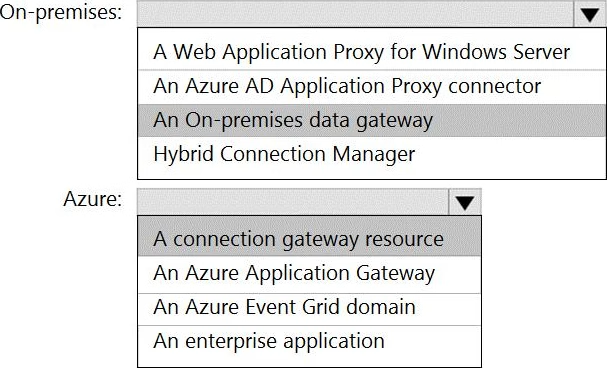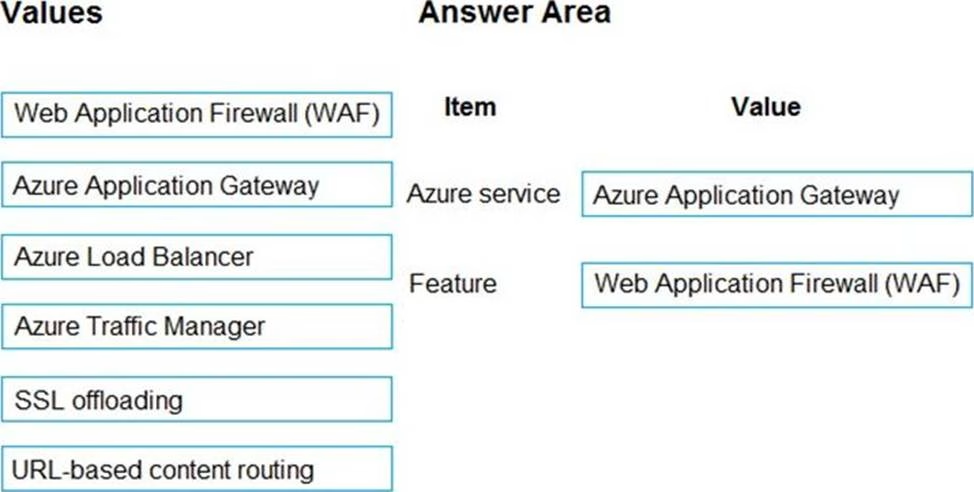Microsoft AZ-305 Designing Microsoft Azure Infrastructure Solutions Online Training
Microsoft AZ-305 Online Training
The questions for AZ-305 were last updated at Dec 19,2025.
- Exam Code: AZ-305
- Exam Name: Designing Microsoft Azure Infrastructure Solutions
- Certification Provider: Microsoft
- Latest update: Dec 19,2025
You have an on-premises network and an Azure subscription. The on-premises network has several branch offices.
A branch office in Toronto contains a virtual machine named VM1 that is configured as a file server.
Users access the shared files on VM1 from all the offices.
You need to recommend a solution to ensure that the users can access the shares files as quickly as possible if the Toronto branch office is inaccessible.
What should you include in the recommendation?
- A . a Recovery Services vault and Azure Backup
- B . an Azure file share and Azure File Sync
- C . Azure blob containers and Azure File Sync
- D . a Recovery Services vault and Windows Server Backup
HOTSPOT
You have an Azure subscription named Subscription1 that is linked to a hybrid Azure Active Directory (Azure AD) tenant.
You have an on-premises datacenter that does NOT have a VPN connection to Subscription1. The datacenter contains a computer named Server1 that has Microsoft SQL Server 2016 installed. Server1 is prevented from accessing the internet.
An Azure logic app named LogicApp1 requires write access to a database on Server1.
You need to recommend a solution to provide LogicApp1 with the ability to access Server1.
What should you recommend deploying on-premises and in Azure? To answer, select the appropriate options in the answer area. NOTE: Each correct selection is worth one point.
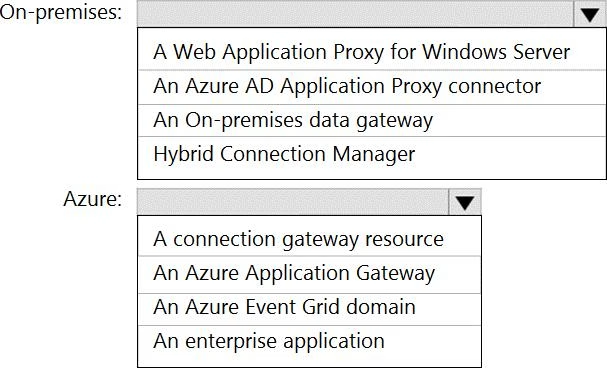
HOTSPOT
Your company develops a web service that is deployed to an Azure virtual machine named VM1. The web service allows an API to access real-time data from VM1.
The current virtual machine deployment is shown in the Deployment exhibit. (Click the Deployment tab).
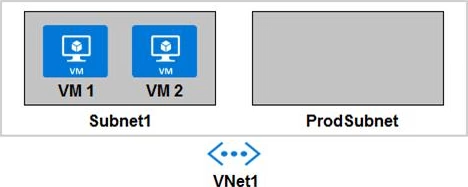
The chief technology officer (CTO) sends you the following email message: “Our developers have deployed the web service to a virtual machine named VM1. Testing has shown that the API is accessible from VM1 and VM2. Our partners must be able to connect to the API over the Internet. Partners will use this data in applications that they develop.”
You deploy an Azure API Management (APIM) service.
The relevant API Management configuration is shown in the API exhibit. (Click the API tab.)

For each of the following statements, select Yes if the statement is true. Otherwise, select No. NOTE: Each correct selection is worth one point.

DRAG DROP
A company has an existing web application that runs on virtual machines (VMs) in Azure.
You need to ensure that the application is protected from SQL injection attempts and uses a layer-7 load balancer. The solution must minimize disruption to the code for the existing web application.
What should you recommend? To answer, drag the appropriate values to the correct items. Each value may be used once, more than once, or not at all. You may need to drag the split bar between panes or scroll to view content. NOTE: Each correct selection is worth one point.
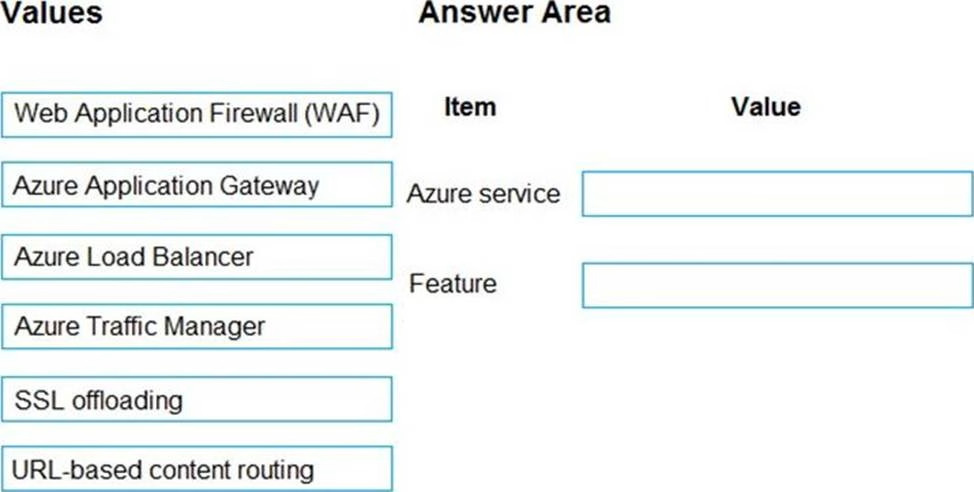
You are designing a microservices architecture that will be hosted in an Azure Kubernetes Service (AKS) cluster. Apps that will consume the microservices will be hosted on Azure virtual machines. The virtual machines and the AKS cluster will reside on the same virtual network.
You need to design a solution to expose the microservices to the consumer apps.
The solution must meet the following requirements:
• Ingress access to the microservices must be restricted to a single private IP address and protected by using mutual TLS authentication.
• The number of incoming microservice calls must be rate-limited.
• Costs must be minimized.
What should you include in the solution?
- A . Azure API Management Premium tier with virtual network connection
- B . Azure Front Door with Azure Web Application Firewall (WAF)
- C . Azure API Management Standard tier with a service endpoint
- D . Azure App Gateway with Azure Web Application Firewall (WAF)
You have .NeT web service named service1 that has the following requirements.
✑ Must read and write to the local file system.
✑ Must write to the Windows Application event log.
You need to recommend a solution to host Service1 in Azure.
The solution must meet the following requirements:
✑ Minimize maintenance overhead.
✑ Minimize costs.
What should you include in the recommendation?
- A . an Azure App Service web app
- B . an Azure virtual machine scale set
- C . an App Service Environment (ASE)
- D . an Azure Functions app
You have the Azure resources shown in the following table.
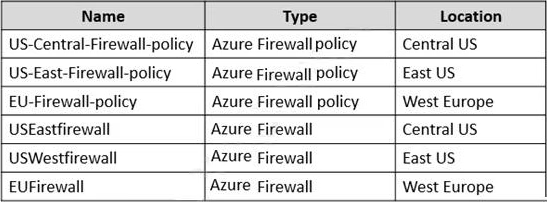
You need to deploy a new Azure Firewall policy that will contain mandatory rules for all Azure Firewall deployments. The new policy will be configured as a parent policy for the existing policies.
What is the minimum number of additional Azure Firewall policies you should create?
- A . 0
- B . 1
- C . 2
- D . 3
Your company has an app named App1 that uses data from the on-premises Microsoft SQL Server databases shown in the following table.
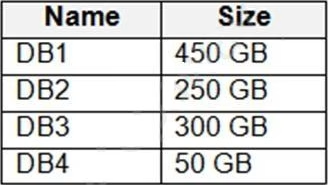
App1 and the data are used on the first day of the month only. The data is not expected to grow more than 3% each year.
The company is rewriting App1 as an Azure web app and plans to migrate all the data to Azure.
You need to migrate the data to Azure SQL Database. The solution must minimize costs.
Which service tier should you use?
- A . vCore-based Business Critical
- B . vCore-based General Purpose
- C . DTU-based Standard
- D . DTU-based Basic
You are developing a sales application that will contain several Azure cloud services and will handle different components of a transaction. Different cloud services will process customer orders, billing, payment, inventory, and shipping.
You need to recommend a solution to enable the cloud services to asynchronously communicate transaction information by using REST messages.
What should you include in the recommendation?
- A . Azure Service Bus
- B . Azure Blob storage
- C . Azure Notification Hubs
- D . Azure Application Gateway
Your company has 300 virtual machines hosted in a VMware environment. The virtual machines vary in size and have various utilization levels.
You plan to move all the virtual machines to Azure.
You need to recommend how many and what size Azure virtual machines will be required to move the current workloads to Azure. The solution must minimize administrative effort.
What should you use to make the recommendation?
- A . Azure Cost Management
- B . Azure Pricing calculator
- C . Azure Migrate
- D . Azure Advisor
Latest AZ-305 Dumps Valid Version with 78 Q&As
Latest And Valid Q&A | Instant Download | Once Fail, Full Refund

